Atrial Fibrillation Management: A Review
VerifiedAdded on 2020/05/16
|7
|1812
|60
AI Summary
This assignment delves into the multifaceted approach to managing atrial fibrillation. It examines current treatment methods, with a particular focus on the use of warfarin for stroke prevention and the associated risks of bleeding. The document also touches upon alternative therapies, monitoring practices, and factors influencing bleeding risk in patients on warfarin.
Contribute Materials
Your contribution can guide someone’s learning journey. Share your
documents today.
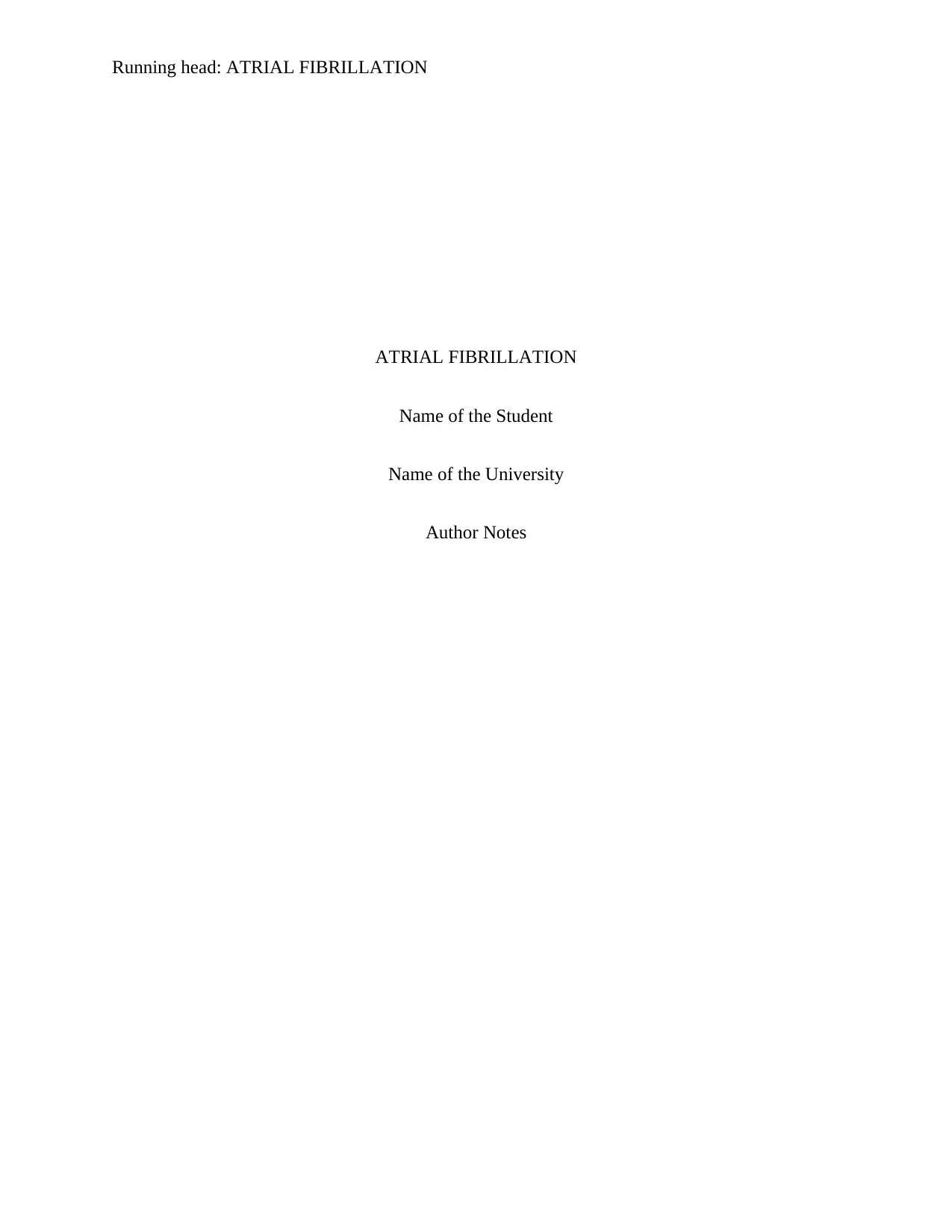
Running head: ATRIAL FIBRILLATION
ATRIAL FIBRILLATION
Name of the Student
Name of the University
Author Notes
ATRIAL FIBRILLATION
Name of the Student
Name of the University
Author Notes
Secure Best Marks with AI Grader
Need help grading? Try our AI Grader for instant feedback on your assignments.
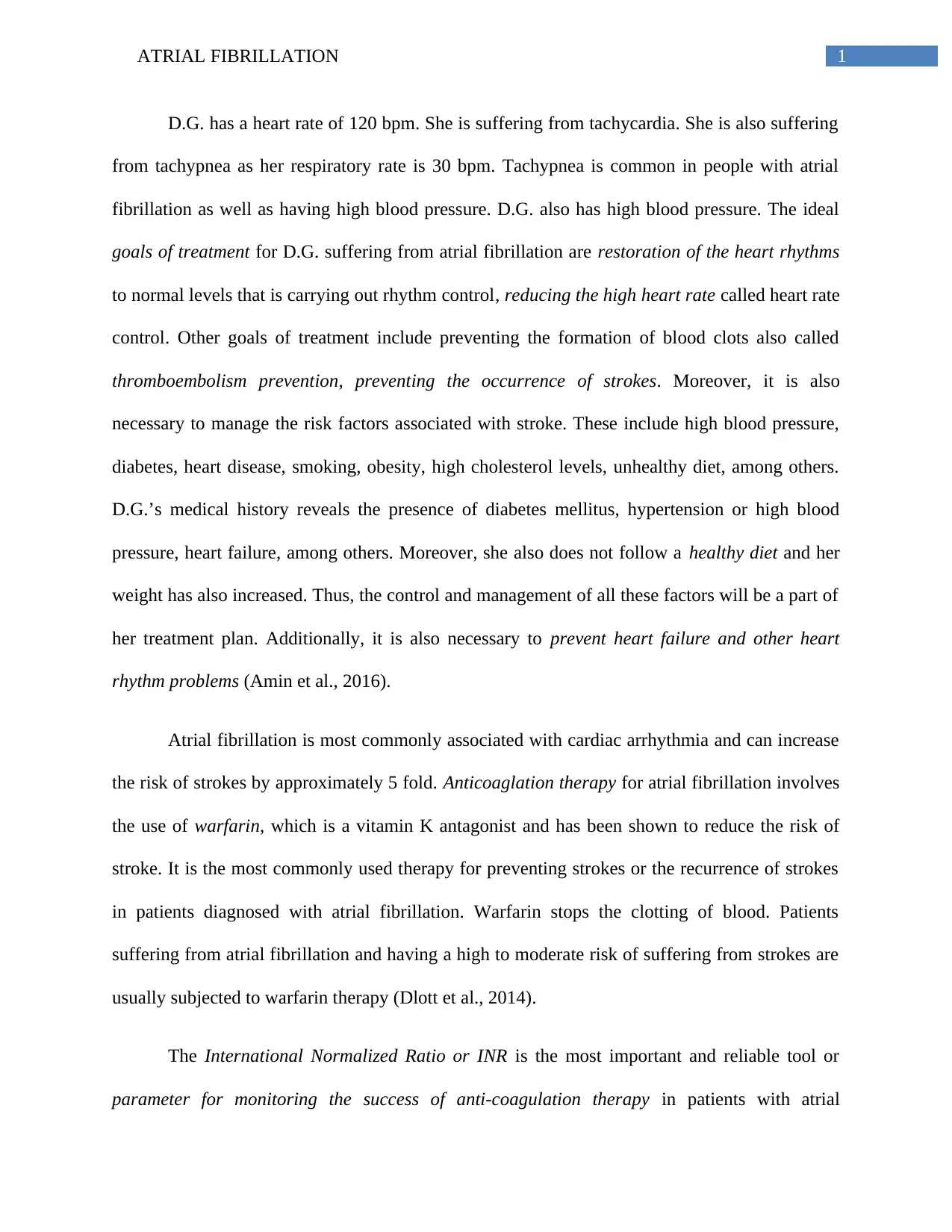
1ATRIAL FIBRILLATION
D.G. has a heart rate of 120 bpm. She is suffering from tachycardia. She is also suffering
from tachypnea as her respiratory rate is 30 bpm. Tachypnea is common in people with atrial
fibrillation as well as having high blood pressure. D.G. also has high blood pressure. The ideal
goals of treatment for D.G. suffering from atrial fibrillation are restoration of the heart rhythms
to normal levels that is carrying out rhythm control, reducing the high heart rate called heart rate
control. Other goals of treatment include preventing the formation of blood clots also called
thromboembolism prevention, preventing the occurrence of strokes. Moreover, it is also
necessary to manage the risk factors associated with stroke. These include high blood pressure,
diabetes, heart disease, smoking, obesity, high cholesterol levels, unhealthy diet, among others.
D.G.’s medical history reveals the presence of diabetes mellitus, hypertension or high blood
pressure, heart failure, among others. Moreover, she also does not follow a healthy diet and her
weight has also increased. Thus, the control and management of all these factors will be a part of
her treatment plan. Additionally, it is also necessary to prevent heart failure and other heart
rhythm problems (Amin et al., 2016).
Atrial fibrillation is most commonly associated with cardiac arrhythmia and can increase
the risk of strokes by approximately 5 fold. Anticoaglation therapy for atrial fibrillation involves
the use of warfarin, which is a vitamin K antagonist and has been shown to reduce the risk of
stroke. It is the most commonly used therapy for preventing strokes or the recurrence of strokes
in patients diagnosed with atrial fibrillation. Warfarin stops the clotting of blood. Patients
suffering from atrial fibrillation and having a high to moderate risk of suffering from strokes are
usually subjected to warfarin therapy (Dlott et al., 2014).
The International Normalized Ratio or INR is the most important and reliable tool or
parameter for monitoring the success of anti-coagulation therapy in patients with atrial
D.G. has a heart rate of 120 bpm. She is suffering from tachycardia. She is also suffering
from tachypnea as her respiratory rate is 30 bpm. Tachypnea is common in people with atrial
fibrillation as well as having high blood pressure. D.G. also has high blood pressure. The ideal
goals of treatment for D.G. suffering from atrial fibrillation are restoration of the heart rhythms
to normal levels that is carrying out rhythm control, reducing the high heart rate called heart rate
control. Other goals of treatment include preventing the formation of blood clots also called
thromboembolism prevention, preventing the occurrence of strokes. Moreover, it is also
necessary to manage the risk factors associated with stroke. These include high blood pressure,
diabetes, heart disease, smoking, obesity, high cholesterol levels, unhealthy diet, among others.
D.G.’s medical history reveals the presence of diabetes mellitus, hypertension or high blood
pressure, heart failure, among others. Moreover, she also does not follow a healthy diet and her
weight has also increased. Thus, the control and management of all these factors will be a part of
her treatment plan. Additionally, it is also necessary to prevent heart failure and other heart
rhythm problems (Amin et al., 2016).
Atrial fibrillation is most commonly associated with cardiac arrhythmia and can increase
the risk of strokes by approximately 5 fold. Anticoaglation therapy for atrial fibrillation involves
the use of warfarin, which is a vitamin K antagonist and has been shown to reduce the risk of
stroke. It is the most commonly used therapy for preventing strokes or the recurrence of strokes
in patients diagnosed with atrial fibrillation. Warfarin stops the clotting of blood. Patients
suffering from atrial fibrillation and having a high to moderate risk of suffering from strokes are
usually subjected to warfarin therapy (Dlott et al., 2014).
The International Normalized Ratio or INR is the most important and reliable tool or
parameter for monitoring the success of anti-coagulation therapy in patients with atrial
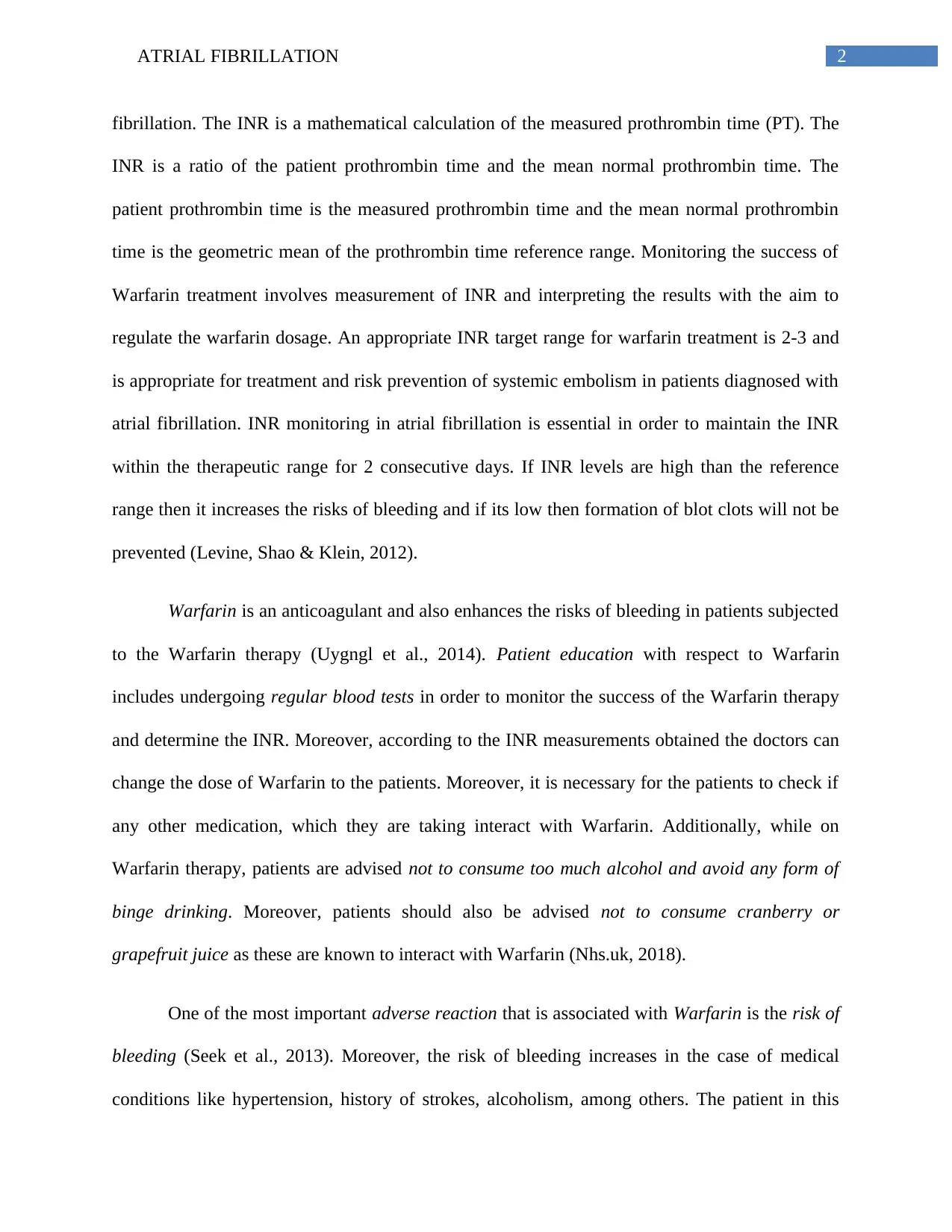
2ATRIAL FIBRILLATION
fibrillation. The INR is a mathematical calculation of the measured prothrombin time (PT). The
INR is a ratio of the patient prothrombin time and the mean normal prothrombin time. The
patient prothrombin time is the measured prothrombin time and the mean normal prothrombin
time is the geometric mean of the prothrombin time reference range. Monitoring the success of
Warfarin treatment involves measurement of INR and interpreting the results with the aim to
regulate the warfarin dosage. An appropriate INR target range for warfarin treatment is 2-3 and
is appropriate for treatment and risk prevention of systemic embolism in patients diagnosed with
atrial fibrillation. INR monitoring in atrial fibrillation is essential in order to maintain the INR
within the therapeutic range for 2 consecutive days. If INR levels are high than the reference
range then it increases the risks of bleeding and if its low then formation of blot clots will not be
prevented (Levine, Shao & Klein, 2012).
Warfarin is an anticoagulant and also enhances the risks of bleeding in patients subjected
to the Warfarin therapy (Uygngl et al., 2014). Patient education with respect to Warfarin
includes undergoing regular blood tests in order to monitor the success of the Warfarin therapy
and determine the INR. Moreover, according to the INR measurements obtained the doctors can
change the dose of Warfarin to the patients. Moreover, it is necessary for the patients to check if
any other medication, which they are taking interact with Warfarin. Additionally, while on
Warfarin therapy, patients are advised not to consume too much alcohol and avoid any form of
binge drinking. Moreover, patients should also be advised not to consume cranberry or
grapefruit juice as these are known to interact with Warfarin (Nhs.uk, 2018).
One of the most important adverse reaction that is associated with Warfarin is the risk of
bleeding (Seek et al., 2013). Moreover, the risk of bleeding increases in the case of medical
conditions like hypertension, history of strokes, alcoholism, among others. The patient in this
fibrillation. The INR is a mathematical calculation of the measured prothrombin time (PT). The
INR is a ratio of the patient prothrombin time and the mean normal prothrombin time. The
patient prothrombin time is the measured prothrombin time and the mean normal prothrombin
time is the geometric mean of the prothrombin time reference range. Monitoring the success of
Warfarin treatment involves measurement of INR and interpreting the results with the aim to
regulate the warfarin dosage. An appropriate INR target range for warfarin treatment is 2-3 and
is appropriate for treatment and risk prevention of systemic embolism in patients diagnosed with
atrial fibrillation. INR monitoring in atrial fibrillation is essential in order to maintain the INR
within the therapeutic range for 2 consecutive days. If INR levels are high than the reference
range then it increases the risks of bleeding and if its low then formation of blot clots will not be
prevented (Levine, Shao & Klein, 2012).
Warfarin is an anticoagulant and also enhances the risks of bleeding in patients subjected
to the Warfarin therapy (Uygngl et al., 2014). Patient education with respect to Warfarin
includes undergoing regular blood tests in order to monitor the success of the Warfarin therapy
and determine the INR. Moreover, according to the INR measurements obtained the doctors can
change the dose of Warfarin to the patients. Moreover, it is necessary for the patients to check if
any other medication, which they are taking interact with Warfarin. Additionally, while on
Warfarin therapy, patients are advised not to consume too much alcohol and avoid any form of
binge drinking. Moreover, patients should also be advised not to consume cranberry or
grapefruit juice as these are known to interact with Warfarin (Nhs.uk, 2018).
One of the most important adverse reaction that is associated with Warfarin is the risk of
bleeding (Seek et al., 2013). Moreover, the risk of bleeding increases in the case of medical
conditions like hypertension, history of strokes, alcoholism, among others. The patient in this
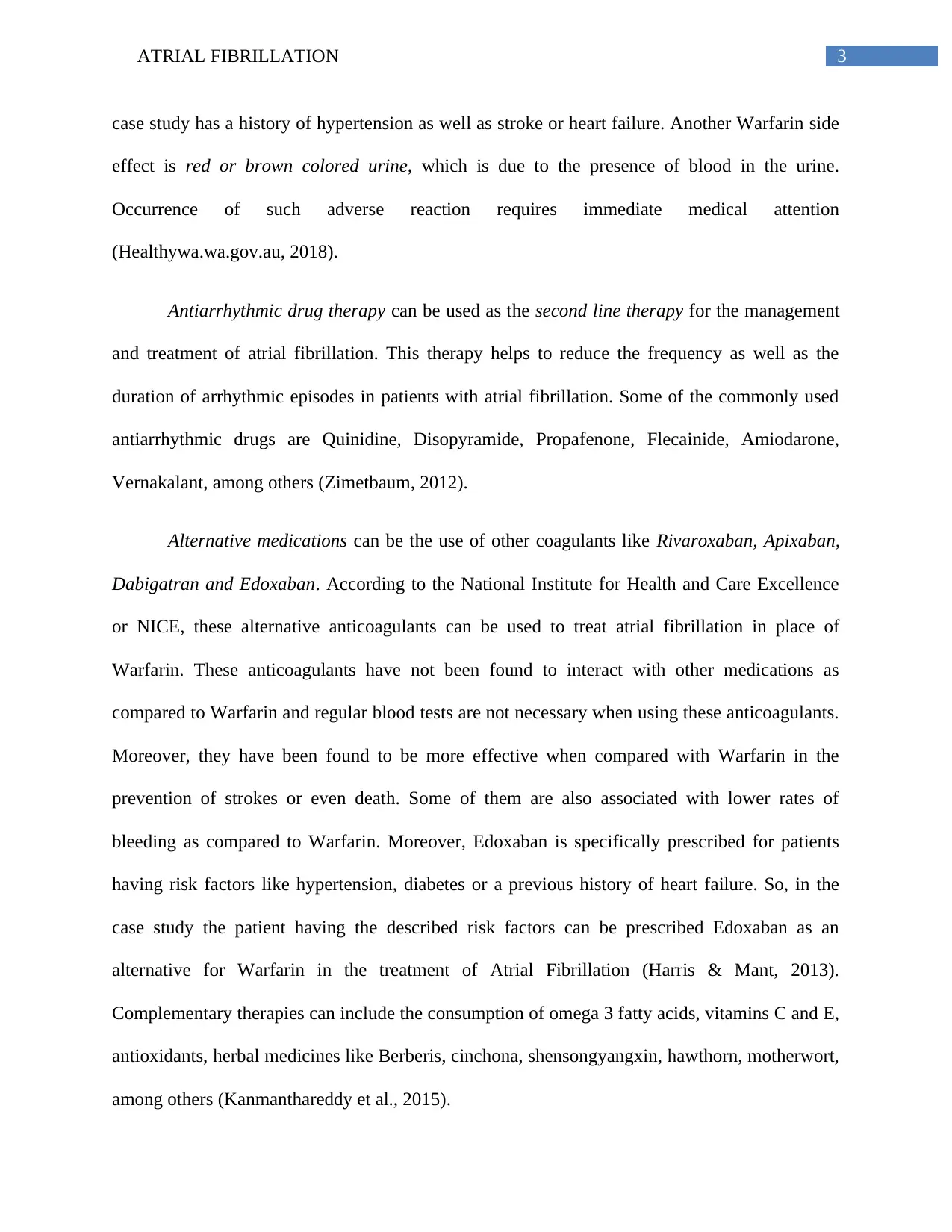
3ATRIAL FIBRILLATION
case study has a history of hypertension as well as stroke or heart failure. Another Warfarin side
effect is red or brown colored urine, which is due to the presence of blood in the urine.
Occurrence of such adverse reaction requires immediate medical attention
(Healthywa.wa.gov.au, 2018).
Antiarrhythmic drug therapy can be used as the second line therapy for the management
and treatment of atrial fibrillation. This therapy helps to reduce the frequency as well as the
duration of arrhythmic episodes in patients with atrial fibrillation. Some of the commonly used
antiarrhythmic drugs are Quinidine, Disopyramide, Propafenone, Flecainide, Amiodarone,
Vernakalant, among others (Zimetbaum, 2012).
Alternative medications can be the use of other coagulants like Rivaroxaban, Apixaban,
Dabigatran and Edoxaban. According to the National Institute for Health and Care Excellence
or NICE, these alternative anticoagulants can be used to treat atrial fibrillation in place of
Warfarin. These anticoagulants have not been found to interact with other medications as
compared to Warfarin and regular blood tests are not necessary when using these anticoagulants.
Moreover, they have been found to be more effective when compared with Warfarin in the
prevention of strokes or even death. Some of them are also associated with lower rates of
bleeding as compared to Warfarin. Moreover, Edoxaban is specifically prescribed for patients
having risk factors like hypertension, diabetes or a previous history of heart failure. So, in the
case study the patient having the described risk factors can be prescribed Edoxaban as an
alternative for Warfarin in the treatment of Atrial Fibrillation (Harris & Mant, 2013).
Complementary therapies can include the consumption of omega 3 fatty acids, vitamins C and E,
antioxidants, herbal medicines like Berberis, cinchona, shensongyangxin, hawthorn, motherwort,
among others (Kanmanthareddy et al., 2015).
case study has a history of hypertension as well as stroke or heart failure. Another Warfarin side
effect is red or brown colored urine, which is due to the presence of blood in the urine.
Occurrence of such adverse reaction requires immediate medical attention
(Healthywa.wa.gov.au, 2018).
Antiarrhythmic drug therapy can be used as the second line therapy for the management
and treatment of atrial fibrillation. This therapy helps to reduce the frequency as well as the
duration of arrhythmic episodes in patients with atrial fibrillation. Some of the commonly used
antiarrhythmic drugs are Quinidine, Disopyramide, Propafenone, Flecainide, Amiodarone,
Vernakalant, among others (Zimetbaum, 2012).
Alternative medications can be the use of other coagulants like Rivaroxaban, Apixaban,
Dabigatran and Edoxaban. According to the National Institute for Health and Care Excellence
or NICE, these alternative anticoagulants can be used to treat atrial fibrillation in place of
Warfarin. These anticoagulants have not been found to interact with other medications as
compared to Warfarin and regular blood tests are not necessary when using these anticoagulants.
Moreover, they have been found to be more effective when compared with Warfarin in the
prevention of strokes or even death. Some of them are also associated with lower rates of
bleeding as compared to Warfarin. Moreover, Edoxaban is specifically prescribed for patients
having risk factors like hypertension, diabetes or a previous history of heart failure. So, in the
case study the patient having the described risk factors can be prescribed Edoxaban as an
alternative for Warfarin in the treatment of Atrial Fibrillation (Harris & Mant, 2013).
Complementary therapies can include the consumption of omega 3 fatty acids, vitamins C and E,
antioxidants, herbal medicines like Berberis, cinchona, shensongyangxin, hawthorn, motherwort,
among others (Kanmanthareddy et al., 2015).
Secure Best Marks with AI Grader
Need help grading? Try our AI Grader for instant feedback on your assignments.
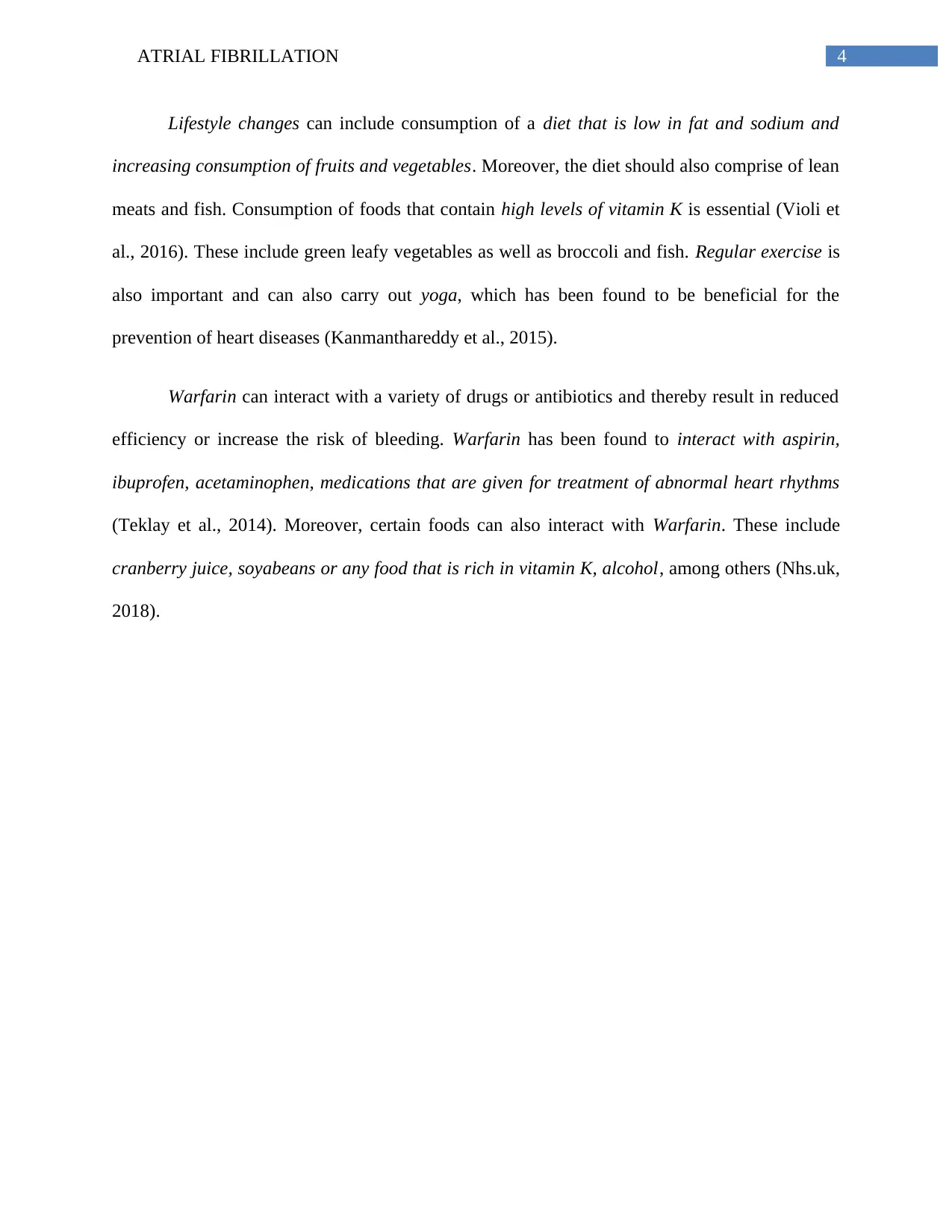
4ATRIAL FIBRILLATION
Lifestyle changes can include consumption of a diet that is low in fat and sodium and
increasing consumption of fruits and vegetables. Moreover, the diet should also comprise of lean
meats and fish. Consumption of foods that contain high levels of vitamin K is essential (Violi et
al., 2016). These include green leafy vegetables as well as broccoli and fish. Regular exercise is
also important and can also carry out yoga, which has been found to be beneficial for the
prevention of heart diseases (Kanmanthareddy et al., 2015).
Warfarin can interact with a variety of drugs or antibiotics and thereby result in reduced
efficiency or increase the risk of bleeding. Warfarin has been found to interact with aspirin,
ibuprofen, acetaminophen, medications that are given for treatment of abnormal heart rhythms
(Teklay et al., 2014). Moreover, certain foods can also interact with Warfarin. These include
cranberry juice, soyabeans or any food that is rich in vitamin K, alcohol, among others (Nhs.uk,
2018).
Lifestyle changes can include consumption of a diet that is low in fat and sodium and
increasing consumption of fruits and vegetables. Moreover, the diet should also comprise of lean
meats and fish. Consumption of foods that contain high levels of vitamin K is essential (Violi et
al., 2016). These include green leafy vegetables as well as broccoli and fish. Regular exercise is
also important and can also carry out yoga, which has been found to be beneficial for the
prevention of heart diseases (Kanmanthareddy et al., 2015).
Warfarin can interact with a variety of drugs or antibiotics and thereby result in reduced
efficiency or increase the risk of bleeding. Warfarin has been found to interact with aspirin,
ibuprofen, acetaminophen, medications that are given for treatment of abnormal heart rhythms
(Teklay et al., 2014). Moreover, certain foods can also interact with Warfarin. These include
cranberry juice, soyabeans or any food that is rich in vitamin K, alcohol, among others (Nhs.uk,
2018).

5ATRIAL FIBRILLATION
Reference List
Amin, A., Houmsse, A., Ishola, A., Tyler, J., & Houmsse, M. (2016). The current approach of
atrial fibrillation management. Avicenna journal of medicine, 6(1), 8.
Dlott, J. S., George, R. A., Huang, X., Odeh, M., Kaufman, H. W., Ansell, J., & Hylek, E. M.
(2014). A national assessment of warfarin anticoagulation therapy for stroke prevention
in atrial fibrillation. Circulation, CirculationAha-113.
Harris, K., & Mant, J. (2013). Potential impact of new oral anticoagulants on the management of
atrial fibrillation‐related stroke in primary care. International journal of clinical
practice, 67(7), 647-655.
Healthywa.wa.gov.au. (2018). Warfarin and risk of bleeding. Healthywa.wa.gov.au. Retrieved 1
February 2018, from http://healthywa.wa.gov.au/Articles/U_Z/Warfarin-and-risk-of-
bleeding
Kanmanthareddy, A., Reddy, M., Ponnaganti, G., Sanjani, H. P., Koripalli, S., Adabala, N., ... &
Vallakati, A. (2015). Alternative medicine in atrial fibrillation treatment—Yoga,
acupuncture, biofeedback and more. Journal of thoracic disease, 7(2), 185.
Levine, M. A., Shao, W., & Klein, D. (2012). Monitoring of international normalized ratios:
comparison of community nurses with family physicians. Canadian Family
Physician, 58(8), e465-e471.
Nhs.uk. (2018). Treatment. nhs.uk. Retrieved 1 February 2018, from
https://www.nhs.uk/conditions/atrial-fibrillation/treatment/
Reference List
Amin, A., Houmsse, A., Ishola, A., Tyler, J., & Houmsse, M. (2016). The current approach of
atrial fibrillation management. Avicenna journal of medicine, 6(1), 8.
Dlott, J. S., George, R. A., Huang, X., Odeh, M., Kaufman, H. W., Ansell, J., & Hylek, E. M.
(2014). A national assessment of warfarin anticoagulation therapy for stroke prevention
in atrial fibrillation. Circulation, CirculationAha-113.
Harris, K., & Mant, J. (2013). Potential impact of new oral anticoagulants on the management of
atrial fibrillation‐related stroke in primary care. International journal of clinical
practice, 67(7), 647-655.
Healthywa.wa.gov.au. (2018). Warfarin and risk of bleeding. Healthywa.wa.gov.au. Retrieved 1
February 2018, from http://healthywa.wa.gov.au/Articles/U_Z/Warfarin-and-risk-of-
bleeding
Kanmanthareddy, A., Reddy, M., Ponnaganti, G., Sanjani, H. P., Koripalli, S., Adabala, N., ... &
Vallakati, A. (2015). Alternative medicine in atrial fibrillation treatment—Yoga,
acupuncture, biofeedback and more. Journal of thoracic disease, 7(2), 185.
Levine, M. A., Shao, W., & Klein, D. (2012). Monitoring of international normalized ratios:
comparison of community nurses with family physicians. Canadian Family
Physician, 58(8), e465-e471.
Nhs.uk. (2018). Treatment. nhs.uk. Retrieved 1 February 2018, from
https://www.nhs.uk/conditions/atrial-fibrillation/treatment/
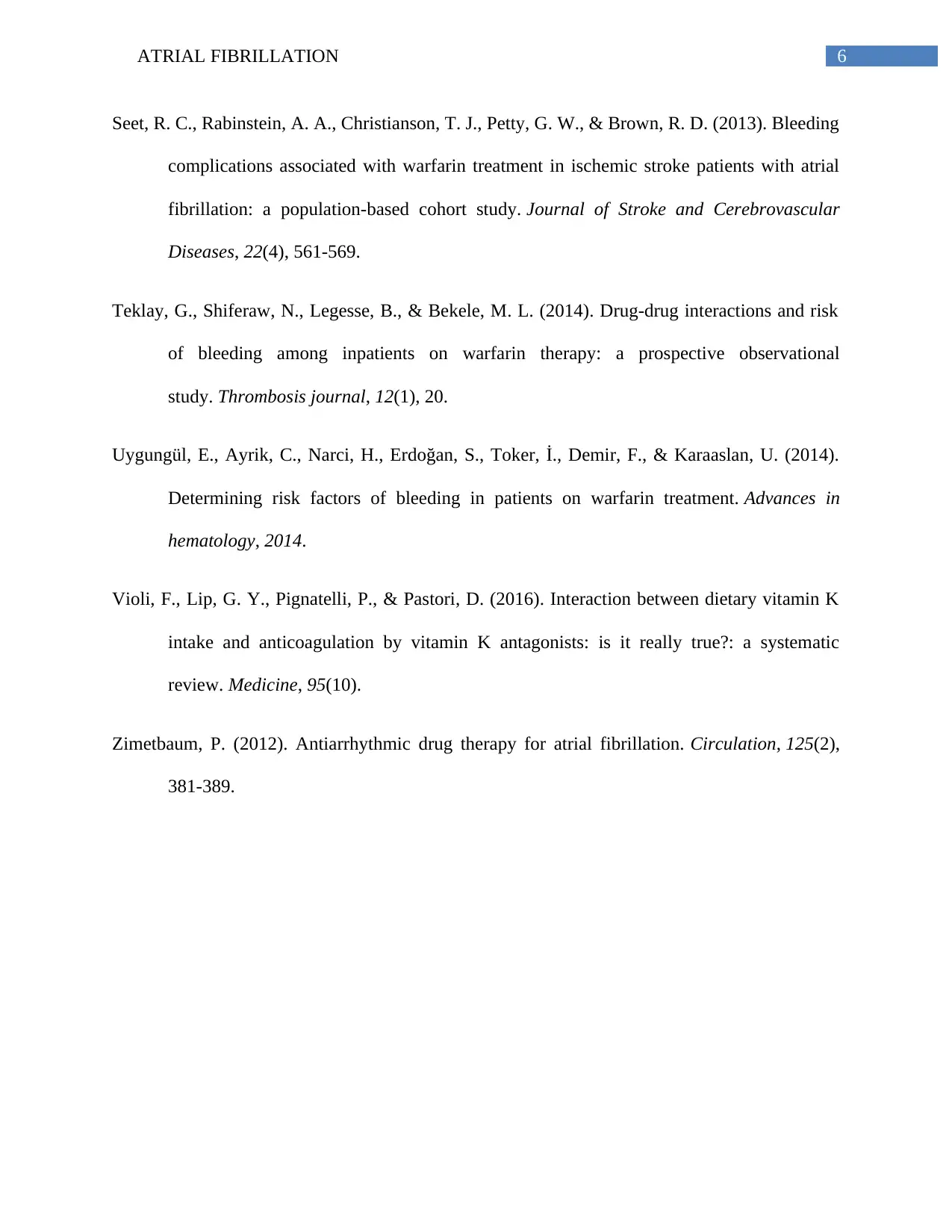
6ATRIAL FIBRILLATION
Seet, R. C., Rabinstein, A. A., Christianson, T. J., Petty, G. W., & Brown, R. D. (2013). Bleeding
complications associated with warfarin treatment in ischemic stroke patients with atrial
fibrillation: a population-based cohort study. Journal of Stroke and Cerebrovascular
Diseases, 22(4), 561-569.
Teklay, G., Shiferaw, N., Legesse, B., & Bekele, M. L. (2014). Drug-drug interactions and risk
of bleeding among inpatients on warfarin therapy: a prospective observational
study. Thrombosis journal, 12(1), 20.
Uygungül, E., Ayrik, C., Narci, H., Erdoğan, S., Toker, İ., Demir, F., & Karaaslan, U. (2014).
Determining risk factors of bleeding in patients on warfarin treatment. Advances in
hematology, 2014.
Violi, F., Lip, G. Y., Pignatelli, P., & Pastori, D. (2016). Interaction between dietary vitamin K
intake and anticoagulation by vitamin K antagonists: is it really true?: a systematic
review. Medicine, 95(10).
Zimetbaum, P. (2012). Antiarrhythmic drug therapy for atrial fibrillation. Circulation, 125(2),
381-389.
Seet, R. C., Rabinstein, A. A., Christianson, T. J., Petty, G. W., & Brown, R. D. (2013). Bleeding
complications associated with warfarin treatment in ischemic stroke patients with atrial
fibrillation: a population-based cohort study. Journal of Stroke and Cerebrovascular
Diseases, 22(4), 561-569.
Teklay, G., Shiferaw, N., Legesse, B., & Bekele, M. L. (2014). Drug-drug interactions and risk
of bleeding among inpatients on warfarin therapy: a prospective observational
study. Thrombosis journal, 12(1), 20.
Uygungül, E., Ayrik, C., Narci, H., Erdoğan, S., Toker, İ., Demir, F., & Karaaslan, U. (2014).
Determining risk factors of bleeding in patients on warfarin treatment. Advances in
hematology, 2014.
Violi, F., Lip, G. Y., Pignatelli, P., & Pastori, D. (2016). Interaction between dietary vitamin K
intake and anticoagulation by vitamin K antagonists: is it really true?: a systematic
review. Medicine, 95(10).
Zimetbaum, P. (2012). Antiarrhythmic drug therapy for atrial fibrillation. Circulation, 125(2),
381-389.
1 out of 7
Your All-in-One AI-Powered Toolkit for Academic Success.
+13062052269
info@desklib.com
Available 24*7 on WhatsApp / Email
![[object Object]](/_next/static/media/star-bottom.7253800d.svg)
Unlock your academic potential
© 2024 | Zucol Services PVT LTD | All rights reserved.





